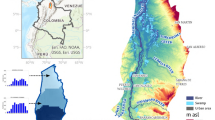Abstract
This study was purposed to examine the use of amino acids as an indicator to determine whether groundwater around carcass burial sites is polluted by livestock wastewater (LW) or carcass leachate (CL). The analysis of samples showed that the average amino acid concentration of carcass leachate (531.897 mg/L; 4341.784 μmol/L) was about 300 times as high as that of livestock wastewater (1.755 mg/L; 16.283 μmol/L). To identify distinct characteristics between LW and CL, six amino acids were paired with one another to calculate their relative composition ratios, which were found to be Leu/Trp (CL 8.39∼98.6, LW 0.89∼4.77), Val/Trp (CL 11.95∼175.38, LW 0.73∼3.62), Lys/Leu (CL 0.01∼0.72, LW 0.96∼8.44), Lys/Ile (CL 0.02∼1.55, LW 1.64∼10.99), Met/Lys (CL 0.14∼0.45, LW 0.03∼0.14), and Ile/Val (CL 0.38∼0.73, LW 0.40∼0.97). The hierarchical clustering result showed that the similarity was 0.617 among the seven LW samples and 0.563 among the seven CL samples, while the similarity between LW and CL samples was 0.198, presenting that these two sources are distinct from each other. All these results indicate that amino acids can be used as a tracer to evaluate if the contamination source is livestock wastewater or carcass leachate. To apply amino acids to tracing pollutants more effectively, however, further studies are needed to understand whether the relative abundance ratios of amino acids are maintained as they are transporting through soils as a medium.

Similar content being viewed by others
References
Beavis, J., & Mott, C. J. B. (1996). Effects of land use on the amino acid composition of soils: 1. Manured and unmanured soils from the Broadbalk continuous wheat experiment, Rothamsted, England. Geoderma, 72, 259–270.
Bedient, P. B., Rifiai, H., & Newell, C. J. (1999). Ground water contamination: transport and remediation (2nd ed., pp. 75–111). Upper Saddle River: Prentice Hall.
Benninger, L. A., Carter, D. O., & Forbes, S. L. (2008). The biochemical alteration of soil beneath a decomposing carcass. Forensic Science International, 180, 70–75.
Cervantes, F. J. (2009). Environmental technologies to treat nitrogen pollution: principles and engineering (pp. 1–22). London: IWA.
Checa-Moreno, R., Manzano, E., Miron, G., & Captan-Vallvey, L. F. (2008). Revisitation of the phenylisothiocyanate-derivatives procedure for amino acid determination by HPLC-UV. Journal of Separation Science, 31, 3817–3828.
Cho, J.-C., Cho, H. B., & Kim, S. J. (2000). Heavy contamination of a subsurface aquifer and a stream by livestock wastewater in a stock farming area, Wonju, Korea. Environmental Pollution, 109, 137–146.
Choi, B. Y., Yun, S. T., Mayer, B., & Kim, K. H. (2011). Sources and biogeochemical behavior of nitrate and sulfate in an alluvial aquifer: hydrochemical and stable isotope approaches. Applied Geochemistry, 26, 1249–1260.
Gwyther, C. L., Williams, A. P., Golyshin, P. N., Edwards-Jones, G., & Jones, D. L. (2011). The environmental and biosecurity characteristics of livestock carcass disposal methods: a review. Waste Management, 31, 767–778.
Hedges, J. I., & Hare, P. E. (1987). Amino acid adsorption by clay minerals in distilled water. Geochemica et Cosmochimica Acta, 51, 255–259.
Heinrikson, R. L., & Meredith, S. C. (1984). Amino acid analysis by reverse-phase high-performance liquid chromatography: precolumn derivatization with phenylisothiocyanate. Analytical Biochemistry, 136, 65–74.
Hiscock, K. M., Lloyd, J. W., & Lerner, D. N. (1991). Review of natural and artificial denitrification of groundwater. Water Research, 25, 1099–1111.
Kim, J. Y., Park, J., Nam, Y., Yoo, E., Lee, W. S., Choi, S., Han, J., & Choi, J. W. (2012). Optimization of analytical method for amino acids by using UFLC-MS/MS. Journal of Korean Society for Environmental Analysis, 15, 107–114.
Korom, S. F. (1992). Natural denitrification in the saturated zone: a review. Water Resources Research, 28, 1657–1668.
Latinopoluos, P. (2000). Groundwater pollution control, Ch1. Nitrate contamination of groundwater: modeling as a tool for risk assessment, management and control (pp. 1–48). Ashurst: WIT.
Mahan, D. C., & Shields, R. G., Jr. (1998). Essential and nonessential amino acid composition of pig from birth to 145 kilograms of body weight, and comparison to other studies. Journal of Animal Science, 76, 513–521.
MacArthur A.J., Milne, J.C. (2002). Leachate characteristics and management requirements arising from the Foot & Mouth Operation in Scotland, Proceeding Waste 2002. Integrated Waste management and Pollution control. Research, Policy and Practice, pp. 305–314
Martinez, J., Dabert, P., Barrington, S., & Burton, C. (2009). Livestock waste treatment systems for environmental quality, food safety, and sustainability. Bioresource Technology, 100, 5527–5536.
Min, J. H., Yun, S. T., Kim, K., Kim, H. S., & Kim, D. J. (2003). Geologic controls on the chemical behavior of nitrate in riverside alluvial aquifers, Korea. Hydrological Processes, 17, 1197–1211.
National Institute of Animal Science, Korean Feeding Standards (2002) Rural Development Association, Korea
Okrouhla, M., Stupka, R., Citdk, J., Sprysl, M., Kluzakova, E., Trnka, M., & Stolc, L. (2006). Amino acid composition of pig meat in relation to live weight and sex. Czech Journal of Animal Science, 51, 529–534.
Pratt, D. L., & Fonstad, T. A. (2009). Livestock mortalities burial leachate chemistry after two years of decomposition. Reno: American Society of Agricultural and Biological Engineers.
Pringle, J. K., Ruffell, A., Jervis, J. R., Donnelly, L., McKinley, J., Hansen, J., Morgan, R., Pirrie, D., & Harrison, M. (2012). The use of geoscience methods for terrestrial forensic searches. Earth-Science Reviews, 114, 108–123.
Russell, H. (2004) Fingerprint analysis of contaminant data: a forensic tool for evaluating environmental contamination. EPA technical support center issue, EPA/600/5-04/054
Tatsi, A. A., & Zouboulis, A. I. (2002). A field investigation of the quantity and quality of leachate from a municipal solid waste landfill in a Mediterranean climate (Thessaloniki, Greece). Advances in Environmental Research, 6, 207–219.
Zaia, D. A. M., Vieira, H. J., & Zaia, C. T. B. V. (2002). Adsorption of l-amino acids on sea sand. Journal of the Brazilian Chemistry Society, 13, 679–681.
Author information
Authors and Affiliations
Corresponding author
Rights and permissions
About this article
Cite this article
Choi, JW., Kim, Jy., Nam, YJ. et al. Comparison of compositional characteristics of amino acids between livestock wastewater and carcass leachate. Environ Monit Assess 185, 9413–9418 (2013). https://doi.org/10.1007/s10661-013-3261-9
Received:
Accepted:
Published:
Issue Date:
DOI: https://doi.org/10.1007/s10661-013-3261-9




